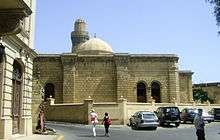Azerbaijan Carpet Museum
Coordinates: 40°21′35″N 49°50′07″E / 40.35972°N 49.83528°E
| Established | 1967 |
|---|---|
| Location | Mikayil Huseynov Street 28, Baku, Azerbaijan |
| Director | Shirin Malikova |
| Public transit access | M 1 Icheri Sheher metro station |
| Website | www.azcarpetmuseum.az |
Azerbaijan Carpet Museum (Azerbaijani: Azərbaycan Xalçası Muzeyi) (formerly called the State Museum of Azerbaijan Carpet and Applied Art (Azerbaijani: Azərbaycan Xalçası və Xalq Tətbiqi Sənəti Dövlət Muzeyi)) displays Azerbaijani carpets and rug items of various weaving techniques and materials from various periods. It is named after Latif Karimov and has the largest collection of Azerbaijani carpets in the world.[1] It moved to a new building on the Baku's seafront park during 2014 from its former location on Neftchiler Avenue.
History

The museum was established in 1967 and was initially located in the Juma Mosque in Icheri Sheher. The mosque was built in the 15th century and renovated in the 19th century. Its first exhibition was held in 1972. In 1992, after the collapse of USSR, the museum was moved to the second floor of what is now the Baku Museum Center,[2] a building that had originally been the Lenin museum.[3] The collection was named in honour of the carpet designer Latif Karimov.
Plans to move the collection to a new purpose-built venue have been in the works since 2010 when Azerbaijani carpets were proclaimed "a Masterpiece of Intangible Heritage" by UNESCO.[4] The new building was due to open in late 2012[4] and was visited by President Ilham Aliyev in September 2013.[5] The museum opened on 26 August 2014. In April 2014 the museum was renamed the Azerbaijan Carpet Museum, dropping its much longer official title.[6]
Collection
The collection of the museum includes over 10,000 items of ceramics, metal works of the 14th century, jewellery from the Bronze Age, carpets and carpet items from the 17th-20th centuries, national garments and embroidery, and applied art works of the Modern Age.[7] The museum organizes public lectures and study courses on carpets and applied arts. It has a book store selling books on Azerbaijani crafts and carpet art.[1] The museum also holds a permanent collection from the Shusha Museum of History, from the city of Shusha, which was looted after occupation by Armenian troops in 1992. Some of the exhibited items of the Shusha museum were saved when the director of the museum moved out 600 carpets before occupation. They are now displayed at the museum in an exhibition titled "Burned Culture".[3]
International exhibitions
The museum does research and public service work. Every year, state and international exhibitions are organized and catalogues on carpets are printed by the museum. The museum has also held exhibitions in more than 30 countries including France, Germany, England, Japan, the Netherlands. In 1998, the museum participated in a UNESCO-organized exhibition in Paris dedicated to Fuzûlî and in 1999 dedicated to the 1,300th anniversary of the Book of Dede Korkut and displayed carpets, folk applied art items, including copper jugs, mugs, buckets and saddle-bags.[3]
See also
References
- 1 2 "AZERBAIJAN CARPET MUSEUM". Archived from the original on July 1, 2010. Retrieved August 20, 2010.
- ↑ Museum Center
- 1 2 3 "Baku's National Carpet Museum". Archived from the original on 11 July 2010. Retrieved August 20, 2010.
- 1 2 New museum planned for late 2012
- ↑ Aliyev inspects new carpet museum
- ↑ Museum renamed
- ↑ "Carpets Made to Last - A Walk Through Baku's National Carpet Museum". Azerbaijan International. Retrieved August 20, 2010.
External links
| Wikimedia Commons has media related to Museum of Azerbaijan Carpet and Applied Art. |
- Official website (Azerbaijani) (English) (Russian)
- Azerbaijan Carpet Museum at Google Cultural Institute
